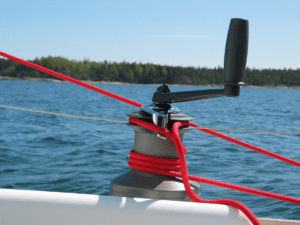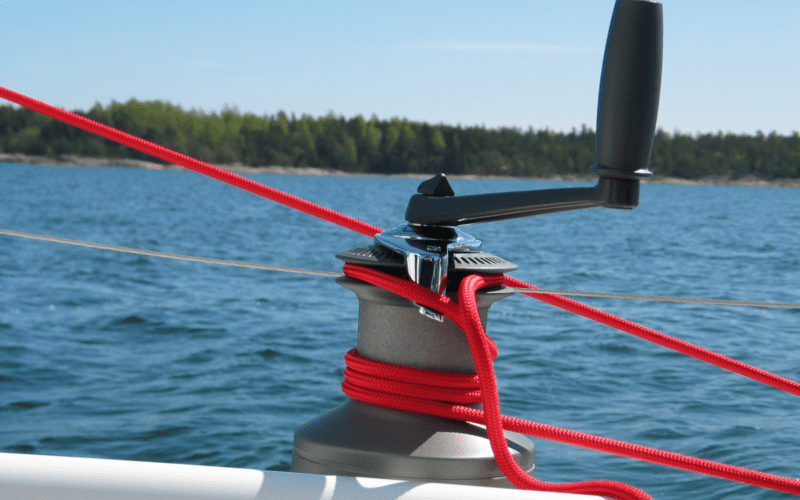By Will Sofrin

Sailing offshore, on a coastal passage or racing, winch overrides can happen. How do you deal with them effectively?
The energy on board is tense. Our rail is pressed hard down, and I am getting covered by walls of white water breaking over our deckhouse. Unfortunately, I wasn’t dressed for these conditions since I thought it would be just another one of our typical Wednesday night beer can races. The race committee was usually pretty good about calling the race off if the conditions got too intense, but not tonight.
“Thirty seconds!” our timekeeper shouts, who is wedged between two other crew members while hiking hard out on the windward rail.
We are on a port tack, easily overpowered and sailing fast, probably close to hull speed. I look below the flapping foot of our jib, hoping it won’t explode. I see a dozen other sailboats from our class heading in our general direction on a starboard tack. Our plan to charge the starting line may not have been the best call since we are a good 15 to 20 seconds early. Too afraid to look back, I could hear our skipper screaming at our tactician, begging to know if he had enough room. Then all of a sudden, he panics and starts tacking the boat before giving anyone notice, “TACKING!”
Everyone on the rail jumps up and starts sprinting across the deck. I barely managed to blow off my jib sheet just as our bow crossed the eye of the wind. My counterpart, the port jib sheet trimmer, started hauling away with all his might. Then all of a sudden, the sheet stops, and he starts shouting every profanity in the dictionary as he jerks the jib sheet with all his weight and might. It doesn’t matter. The sheet won’t budge, the boat is heeled over, and the jib is loaded up but still needs to be wound in a few more feet. He panics, the skipper screams, and I hop down to help. Locking my eyes on it, I see one of the nastiest overrides I’ve ever encountered.
An override happens when the working end of a line slides up the drum fouling the other wraps right before it loads up. In our case, since we were dealing with a jib sheet, we needed to wrap the tail end of the sheet counterclockwise around the winch drum. When doing this, only be sure to take just one-half wrap, nothing more. Pull with all your might, but that won’t be enough in most cases. If it is, you will feel a big jolt as you release one of the jammed wraps pinched under the loaded sheet. You will then need to take another counterclockwise wrap around the drum and repeat until you have pulled out all the overridden wraps. If that works, your jib sheet will eventually be released. You can then reload the winch clockwise at that point and start cranking in the sheet.
I have found that nine times out of ten, the load on the sheet will likely require much more than brute strength, depending on the size of the jib, the amount of wind, and the diameter of the sheet. If you can’t pull it out, you’ve got to go to Plan B, which means leading the fouled sheet to another winch because of the power needed to pull the override out. In our situation, we had a clean fair lead to run the tail of our overridden sheet to our windward jib winch. Mind you, we still needed to make that counterclockwise wrap on the fouled drum before loading up the free windward winch.
With the windward winch loaded up, you are going to grind that winch until it pulls out an overridden wrap from the fouled winch. The sudden release usually comes with a loud pop. Then quickly unload the windward winch so you can take another counterclockwise half wrap around the fouled winch. Then reload the windward winch and repeat the process until all the fouled wraps have been released. A benefit of this method is that once the final fouled wrap has been pulled out, the trimmer can use the loaded windward winch to trim in the jib. I recommend you consider doing this because of the lost time if you are in a race. If you are simply cruising, reload the leeward winch and grind that jib sheet in!
So, how does one prevent an override from happening?
The best way to prevent an override is to make sure that your fair lead to the winch is as low as possible. A high lead will inevitably cause a situation in which the sheet rises as the load increases. I have also learned that preloading your winch with only two to three wraps at most can help prevent an override. The goal is to be vigilant about pulling out any slack from your jib sheet once the tack has been initiated. You will only have a few seconds to haul away after the bow of your boat has crossed through the eye of the wind. Then when you start to feel a bit of load, quickly add two to three more wraps to your winch. You will need to be quick with this, but after a few times, you won’t need to think much about what to do. At that point, load the sheet into the self-tailor and grind away.
Will Sofrin lives in Los Angeles with his wife and six-year-old daughter. He is a graduate of IYRS School of Technology & Trades, where he apprenticed in the wooden boat restoration program. After completing the program, he spent a decade working as a professional sailor, earning his 100-ton master’s license, and using his specialized wood-working skillset to secure positions on yachts and ships sailing through Europe, New England, the Caribbean, Central America, and the California coast. In 2014 he launched a design firm specializing in managing the restoration of historic homes and developing ground-up architectural packages for luxury residential homes. He still sails actively on his Pearson 33-2, participating in races in Santa Monica Bay as well as a number of double-handed near coastal races. His new book is All Hands on Deck, A Modern Day High Seas Adventure to the Far Side of the World.

